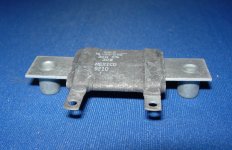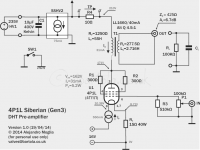Was PERESTROIKA good for valve production?
Or the Russian Federation? Or were the best made for Brezhnev?
That is the question.
I have no idea. My speculation could go either way. These being made for military use which period would have inspired the best quality control? Reasons pro and con for each period come to mind.
And then there is the mind teaser - what if the best sounding tubes were the least good for their intended use?
In audio, all things are possible ...
Or the Russian Federation? Or were the best made for Brezhnev?
That is the question.
I have no idea. My speculation could go either way. These being made for military use which period would have inspired the best quality control? Reasons pro and con for each period come to mind.
And then there is the mind teaser - what if the best sounding tubes were the least good for their intended use?
In audio, all things are possible ...
Member
Joined 2006
Yeh, those aluminium clads do the job. I'm using one on a finned sink right now, pitty those fins are so ugly in sight. I was thinking about sawing the deck plate up and putting a plate of copper through. I did that before a couple of years ago, the heat conducts nicely to the rims of the plate.
Like this:
Like this:
An externally hosted image should be here but it was not working when we last tested it.
An externally hosted image should be here but it was not working when we last tested it.
A quick question.
Are the vintage nos 4p1ls (from 70-80s) sonically better than the newer ones currently available on ebay? Thanks!
I personally prefer the Svetlana production from early 70s. I have a batch from 1973. They are not easy to find I think. Also tried Saratov Reflector from the 80s. There is not a big difference you can notice.
I haven't tried the Chinese versions though...
Ale
Disco,
Why not use one of those gold metal wrapped resistors for the cathode and mount a small heatsink between the tubes and then mount the resistors to that heatsink?
Like these:

I read somewhere that they are pretty good sounding resistors.
Really? I didn't like them at all. I believe some other guys haven't had a good experience with the Alu-clad ones. I rather go for vitreous wire wound or NOS WW ones (e.g. DALE).
Ale
Dont know if they have the values you need, but I have become quite fond of the Ohmite WN series. Inexpensive and excellent performers, at least from a numbers perspective.
http://www.ohmite.com/cat/res_wh_wn.pdf
http://www.ohmite.com/cat/res_wh_wn.pdf
Alu clad is never bifilar wound if I'm not mistaken, some wirewound are. Those 25W clads will probably go round no more than 6 times, so the inductance will be in mH range. What impact will this small inductance have to the circuit at hand?
Those Ohmite 5W are non inductive moulded wirewounds. I don't see them often here..
Those Ohmite 5W are non inductive moulded wirewounds. I don't see them often here..
Last edited:
Member
Joined 2006
I personally prefer the Svetlana production from early 70s. I have a batch from 1973. They are not easy to find I think. Also tried Saratov Reflector from the 80s. There is not a big difference you can notice.
I haven't tried the Chinese versions though...
Ale
Thanks Ale.
I just ordered a few pairs from two different periods.🙂
Those Ohmite 5W are non inductive moulded wirewounds. I don't see them often here..
Is there something in their datasheet or construction that would suggest a negative result?
They come both inductive and non-inductive (bifilar wound). Inductance in the wrong place might cause a HF falll off. I can't simulate the circuit, Ale can 😉
They come both inductive and non-inductive (bifilar wound). Inductance in the wrong place might cause a HF falll off. I can't simulate the circuit, Ale can 😉
You're right. I didn't attribute this to the inductive WW ones as haven't looked it into it properly (nor simulated or measured it). I simply didn't like the sound but can't remember now whether there was a loss of treble or not. It might be worth trying the non-inductive ones for sure.
Ale
Mine resistors are on the way😉
Attachments
Last edited:
Dale/Vishay flat wounds 30W.
Type HL= inductive, Type NHL= non inductive.
Tempco is ca 30 ppm / degree
Type HL= inductive, Type NHL= non inductive.
Tempco is ca 30 ppm / degree
Hence the recommendation of the non inductive WN series. I have yet to find a comparable product anywhere close to the price with similar specs. I have comopared them directly to Caddocks, Vishay RS, Vishay Ns, Panasonic ERJ, Fukushima MPC74 and have found no real discernable difference in sound. That being said, they have always been used in non signal path locations. There performance is good enough that I will be trying them in the signal path on the 6v6 pre I am about to finish.Inductance in the wrong place might cause a HF falll off.
Wishay-Dale NH series resistors are non inductive (Ayrton-Perry winding) ones.Alu clad is never bifilar wound ..
I use W-D 50W NH resistors in the heater bias circuits.
NH0508R000FC02 Vishay / Dale | Mouser
http://www.mouser.com/ds/2/427/30201-220018.pdf
A change to the impedance of the cathode circuit influences the anode circuit. I don't know how big a change it takes to be noticeable by ears.
Inductive resistors in the power supply don't mind because its inductance is shunted by the adjacent capacitor. It's at the locations where high amplification occurs that matter, like the anode and to some degree the cathode, especially when not bypassed.
There you have it, aluminium clad can be had non inductive too 😉
Did you have the opportunity to compare those to other resistors?
Inductive resistors in the power supply don't mind because its inductance is shunted by the adjacent capacitor. It's at the locations where high amplification occurs that matter, like the anode and to some degree the cathode, especially when not bypassed.
There you have it, aluminium clad can be had non inductive too 😉
Did you have the opportunity to compare those to other resistors?
Last edited:
Really? I didn't like them at all. I believe some other guys haven't had a good experience with the Alu-clad ones. I rather go for vitreous wire wound or NOS WW ones (e.g. DALE).
Ale
I am pretty sure I read that from the late Allen Wright. I don't recall if it was all types of Alu clad, or just one type. I'll look it up sometime.
Ale is possible to use 10R as filament resistor in place of 15R? if yes what's the output voltage to set the Rod Coleman heaters reg.? have I to change also the B+ voltage?
Attachments
Last edited:
Merlin - I'm sure you know how to work this out by now. You use ohms law and the 4P1L curves to work out your operating point and the resistor that corresponds to the voltage and current. Then take the voltage at the top of the resistor, add the filament voltage (+-2v) and that's the output voltage of the Coleman reg. The input voltage is that plus around 6v for the reg. You must have done these calculations before when you were building your 26 preamp.
I am pretty sure I read that from the late Allen Wright. I don't recall if it was all types of Alu clad, or just one type. I'll look it up sometime.
I didn't like the alu clad resistors. The ceramic white ones were worse, and thick film worst of all. I did all this A-B testing a while ago and I came across the Dale remaindered stock on ebay and posted the good results I had with them, and that's what a lot of us have been using. They have the advantage of being easy to attach. The porcelain clad ones are also good, but pose the issue of how to attach them so the insulation (nylon, etc) doesn't fry and eventually fall apart with the heat.
- Home
- Amplifiers
- Tubes / Valves
- 4P1L DHT Line Stage

